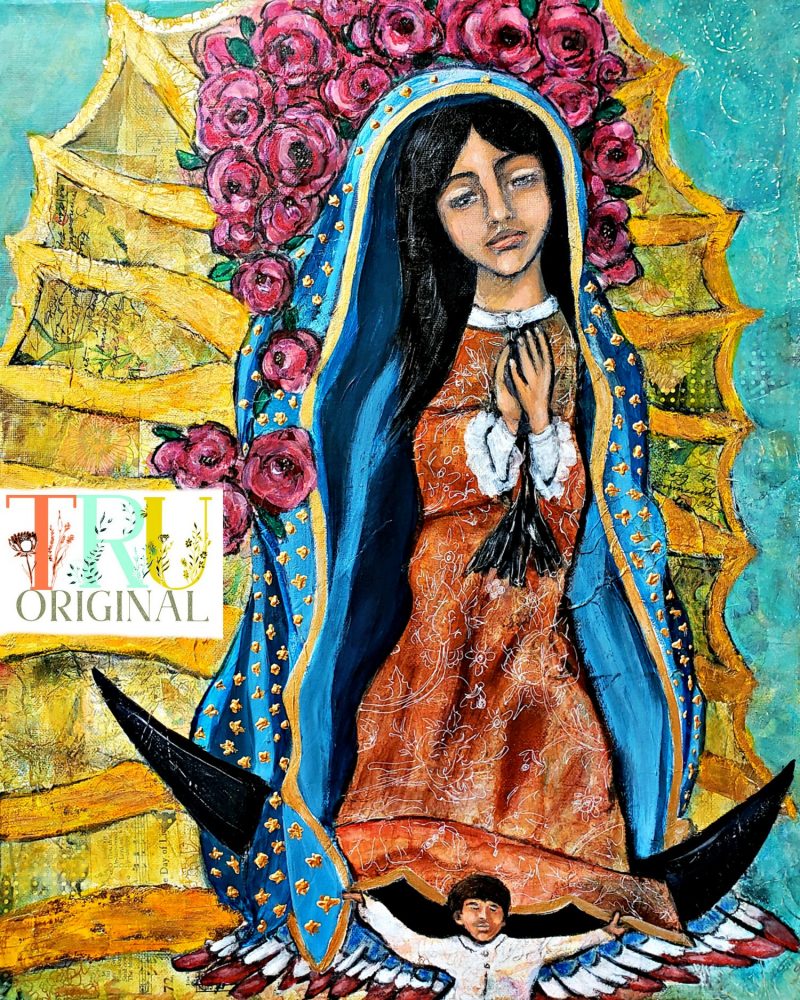December’s Saint of the Month
Our Lady of Guadalupe!

On Dec. 12, the Catholic Church celebrates the Feast of Our Lady of Guadalupe, Patroness of the Americas, marking the day when, in 1531, the Blessed Mother appeared in Mexico to a 57-year old peasant named Juan Diego. According to the earliest reliable account of the story, Juan Diego was walking near Tepayac Hill (called Mexico City today) when he encountered a beautiful woman surrounded by a ball of light as bright as the sun. Speaking in his native tongue, the beautiful lady identified herself: “My dear little son, I love you. I desire you to know who I am. I am the ever-virgin Mary, Mother of the true God who gives life and maintains its existence. He created all things. He is in all places. He is Lord of Heaven and Earth. I desire a church in this place where your people may experience my compassion. All those who sincerely ask my help in their work and in their sorrows will know my Mother’s Heart in this place. Here I will see their tears; I will console them and they will be at peace. So run now to Tenochtitlan and tell the Bishop all that you have seen and heard.”
In trying to convince the archbishop of what he had seen, Juan Diego eventually was asked for a sign to prove what he had seen. Upon returning to Mary and sharing this with her, Mary said “My little son, am I not your Mother? Do not fear. The Bishop shall have his sign. Come back to this place tomorrow. Only peace, my little son.” Unfortunately, Juan was not able to return to the hill the next day. His uncle had become mortally ill and Juan stayed with him to care for him. After two days, with his uncle near death, Juan left his side to find a priest. Juan had to pass Tepayac Hill to get to the priest. As he was passing, he found Mary waiting for him. She spoke: “Do not be distressed, my littlest son. Am I not here with you who am your Mother? Are you not under my shadow and protection? Your uncle will not die at this time. There is no reason for you to engage a priest, for his health is restored at this moment. He is quite well. Go to the top of the hill and cut the flowers that are growing there. Bring them then to me.” While it was freezing on the hillside, Juan obeyed Mary’s instructions and went to the top of the hill where he found a full bloom of Castilian roses which were neither in season nor native to the region. Removing his tilma, a poncho-like cape made of cactus fiber, he cut the roses and carried them back to Mary. She rearranged the roses and told him: “My little son, this is the sign I am sending to the Bishop. Tell him that with this sign I request his greatest efforts to complete the church I desire in this place. Show these flowers to no one else but the Bishop. You are my trusted ambassador. This time the Bishop will believe all you tell him.” At the palace, Juan once again came before the bishop and several of his advisors. He told the bishop his story and opened the tilma letting the flowers fall out. But it wasn’t the beautiful roses that caused the bishop and his advisors to fall to their knees; for there, on the tilma, was a picture of the Blessed Virgin Mary precisely as Juan had described her. The next day, after showing the Tilma at the Cathedral, Juan took the bishop to the spot where he first met Mary. He then returned to his village where he met his uncle who was completely cured. His uncle told him he had met a young woman, surrounded by a soft light, who told him that she had just sent his nephew to Tenochtitlan with a picture of herself. She told his uncle:”Call me and call my image Santa Maria de Guadalupe”.
Within six years of this apparition, six million Aztecs had converted to Catholicism! The tilma shows Mary as the God-bearer – she is pregnant with her Divine Son. Since the time the tilma was first impressed with a picture of the Mother of God, it has been subject to a variety of environmental hazards including smoke from fires and candles, water from floods and torrential downpours and, in 1921, a bomb which was planted by anti-clerical forces on an altar under it. There was also a cast-iron cross next to the tilma and when the bomb exploded, the cross was twisted out of shape, the marble altar rail was heavily damaged and the tilma was…untouched!
In 1977, the tilma was examined using infrared photography and digital enhancement techniques. Unlike any painting, the tilma shows no sketching or any sign of outline drawn to permit an artist to produce a painting. Further, the very method used to create the image is still unknown. The image is inexplicable in its longevity and method of production. It can be seen today in a large cathedral built to house up to ten thousand worshipers. It is, by far, the most popular religious pilgrimage site in the Western Hemisphere.
Our Lady of Guadalupe, St Juan Diego…pray for us!
